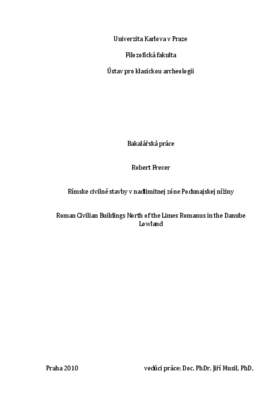Rímske civilné stavby v nadlimitnej zóne Podunajskej nížiny
Roman civilian buildings north of the limes romanus in the Danube lowland
Římské civilní stavby v nadlimitné zoně Podunajské nížiny
bakalářská práce (OBHÁJENO)

Zobrazit/
Trvalý odkaz
http://hdl.handle.net/20.500.11956/38226Identifikátory
SIS: 91272
Katalog UK: 990013753870106986
Kolekce
- Kvalifikační práce [24977]
Autor
Vedoucí práce
Oponent práce
Bouzek, Jan
Fakulta / součást
Filozofická fakulta
Obor
Klasická archeologie
Katedra / ústav / klinika
Ústav pro klasickou archeologii
Datum obhajoby
13. 9. 2010
Nakladatel
Univerzita Karlova, Filozofická fakultaJazyk
Slovenština
Známka
Výborně
Práca pojednáva o existencii stavieb vybudovaných rímskymi stavebnými technikami a s civilnou funkciou v tej časti Podunajskej nížiny mimo Impéria, ktorá bola ako výnimočná oblasť historicky bezprostredne v kontakte s rímsko-provinciálnou civilizáciou počas prvých štyroch storočí po Kr. Po geografickom opise nadlimitnej zóny nasleduje podrobný historický prehľad, ktorý poskytuje rámec pre interpretáciu stavieb. Predložený materiál zahŕňa všetky doklady rímskej architektúry v predmetnom časovom období, a to in situ ako aj v sekundárnych nálezoch stavebného materiálu. Analýza delí materiál na dva druhy civilných stavieb - stavby villového typu, a menšie stavby. Do prvej kategórie spadajú tie stavby, ktoré vychádzajú z provinciálnej obytnej architektúry, a zahŕňa štruktúry budované pre civilné účely v rámci vojenského ťaženia (Mušov-Neurissen), areály na vzor provinciálneho ekonomického systému villa rustica (Stupava, Bratislava-Dúbravka), ako aj domnelé sídla významných osobností z domáceho etnika (Oberleisenberg, Cífer-Pác). Druhý typ menších stavieb zahŕňa tzv. "stavby II", ktoré boli súčasťami horeuvedených komplexov germánskych sídiel, stavby s kombinovanými rímsko-barbarskými stavebnými technikami (Bratislava-Devín), ako aj sakrálne stavby (Bratislava-Devín, Niederleis). Nasledujúci technický opis...
The thesis deliberates the existence of civilian structures built with Roman construction techniques in that part of the Danube Lowland outside the Empire which had unique contacts with the Roman provincial milieu of the first four centuries A.D. A geographical description of this area north of the Limes Romanus is followed by a detailed historical overview to serve as a framework for the interpretation of such buildings. The presented material includes all instances of Roman architecture from the time period in question, both in situ and inferred from secondary finds of construction material. The analysis sorts this material into two types of civilian buildings - villa-like structures, and smaller buildings. The former category designates those buildings that draw from provincial house architecture, and comprises structures built for civilian use during military campaigns (Mušov-Neurissen), facilities similar in function to the provincial economic system of the villa rustica (Stupava, Bratislava-Dúbravka), as well as probable residences for important figures of the Marcomanni and Quadi (Oberleisenberg, Cífer- Pác). The second, smaller type consists of so-called "buildings II" that were part of the abovementioned Germanic residence developments, buildings with composite roman-barbarian construction...
